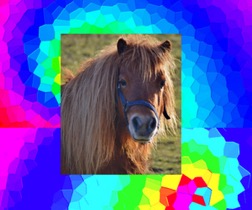Benefits of Colour Your Animal Can Enjoy

What is Colour Therapy
Also known as Chromotherapy or “Colorology”, this is a holistic technique which is believed to help rebalance the body, (emotionally, mentally, physically and spiritually). It works by applying colour and light to specific areas on the body.
For many years colour therapy has been used to help the health of humans. E.g. have you ever considered the difference the colour of walls makes to your mood or anyone you know?. Over recent years the use and effect of colours to help animals has been gaining popularity.
How Does Colour Therapy Help Animals?
Different colours have different effects on the animal - which colour is down to the specific animal and its specific needs, including:
- White: Clarity/purity
- Blue: Tranquility - help pacify a nervous animal
- Green: Relieves tension
- Red: Increasing energy. Often better used sparingly as although can help with stamina. It can also create agitation. (Don't use red if there's any inflammation, as can make it worse)
- Yellow: Can be uplifting. Also providing comfort/warmth, helpful in training where reassurance needed
- Orange: Help stimulate blood supply and energising nerves
- Purple: Combines the warmth of red and cooling of blue. Stimulates without aggravating. Soothes nervous system
- Brown: Neutrality. Help keep things normal.
The colours can be applied using various methods, including: gemstones, wands, prisms, coloured fabrics. This can be by a therapist/Vet using colours in a therapy session. They can use light pens, cards, fabrics, charged water (coloured glass bottles with distilled water left in sunlight for a period of time). On an everyday level, you can choose particular colour feed bowls/water buckets. Or other day to day objects to have a positive effect on your animal's wellbeing.
If your animal is recovering from illness, or just in need of some TLC, then using different colours could help him/her feel more relaxed or even more positive.
Can Animals See Different Colours?
Research has shown that animals can see colour – although it’s believed this is in a different way to what humans do. Different species of animals will also see varying colours. For example a cat will see differently to a dog and so on. Science says that everything has a vibration/frequency, and that includes colours. So, as colour is light of differing wavelengths, it's this energy that produces the effect on the animal. Remember that not all colours can be seen - even by humans - ultraviolet light (UV) can't be seen, but it still burns or tans our skin. The same holds true for animals.
Some horses who showjump, may prefer jumping over certain colour poles. Research was conducted in 2014 that found horses had more faults over blue colour poles - read more about this fascinating research online here.
Who Can Practise Colour Therapy?
There are many complementary therapists working with animals and even Vets who use colour therapy as part of their treatment. Colour therapy is usually used as part of a holistic approach to promoting animal wellbeing, rather than by itself.
As is the case before using any complementary therapy, if your animal is unwell or experiencing any particular problems, then you should always seek professional help from your Veterinary Surgeon.
Do try "experimenting" with different colour bowls, blankets, rugs, beds, buckets, etc to see what your horse, dog or other animal prefers. You maybe surprised!
Even different foods in their different colours can make a difference to your animal. Who wants to eat brown food all the time?! Some may not bother. But it can get boring or be unappetising to others. Each animal is different, all are unique and sensitive.
Learn more about light and laser therapy in this advice page.
You Can Read More Information On Veterinary Laser Therapy With These Research Articles
Wave behaviours https://science.nasa.gov/ems/03_behaviors
Understanding science of veterinary laser therapy https://www.veterinarypracticenews.com/understanding-science-of-laser-therapy/
"An investigation into the depth of penetration of low level laser therapy through the equine tendon in vivo" (The Irish Veterinary Journal)
Would you like information on Veterinary Surgeons or other holistic therapists who use colour, light or laser therapy near you? Please email us at info@taranet.co.uk - I'll be pleased to try and assist!
You can get more information on many complementary therapies for animals here at Taranet. Take a look at the sitemap here for a list.
About The Author
This article has been extensively researched and written by Suzanne Harris. Who is also the designer and developer of this site. A lifelong animal lover with a passion for ensuring animals can access complementary therapies for their health and wellbeing.
